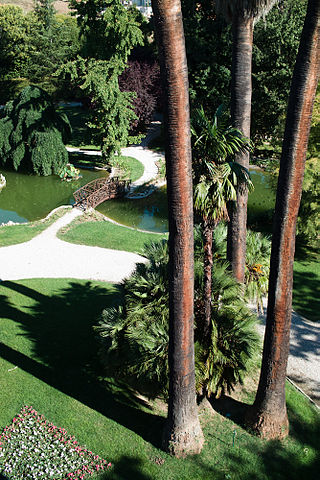
The Province of Imperia is a mountainous and hilly province, in the Liguria region of Italy, situated between France to the north and the west, and the Ligurian Sea, an arm of the Mediterranean Sea to the south. Its capital is the city of Imperia.

Verbania is the most populous comune (municipality) and the capital city of the province of Verbano-Cusio-Ossola in the Piedmont region of northwest Italy. It is situated on the shore of Lake Maggiore, about 91 km (57 mi) north-west of Milan and about 40 km (25 mi) from Locarno in Switzerland. It had a population of 30,827 at 1 January 2017.

Bordighera is a town and comune in the Province of Imperia, Liguria (Italy).

Phoenix canariensis, the Canary Island date palm or pineapple palm, is a species of flowering plant in the palm family Arecaceae, native to the Canary Islands off the coast of Northwestern Africa. It is a relative of Phoenix dactylifera, the true date palm. It is the natural symbol of the Canary Islands, together with the canary Serinus canaria. Mature P. canariensis are often used in ornamental landscaping and are collected and transplanted to their new planting location. A Canary Island date palm with 10 m (30 ft) of trunk is about 60 years of age.

The Giardini Botanici Hanbury, also known as Villa Hanbury, are major botanical gardens operated by the University of Genoa. They are located at Corso Montecarlo 43, Mortola Inferiore, several km west of Ventimiglia, Italy.

The flora of Italy is all the plant life present in the territory of the Italian Republic. The flora of Italy was traditionally estimated to comprise about 5,500 vascular plant species. However, as of 2019, 7,672 species are recorded in the second edition of the flora of Italy and in its digital archives Digital flora of Italy. In particular, 7,031 are autochthonous and 641 are non native species widely naturalized since more than three decades. Additionally, further 468 exotic species have been recorded as adventitious or naturalized in more recent times.

Ludwig Winter was a German botanist, nurseryman and landscape designer, creator of gardens such as the Giardini Botanici Hanbury, noted for introducing tall palms and other foreign species to the Ligurian riviera.

Daniel Hanbury FRS was a British botanist and pharmacologist. He was an early student of pharmacognosy, the study of the medicinal applications of nature, principally of plants.

The Borgo Storico Seghetti Panichi near Ascoli Piceno in Marche region of central Italy comprises a 13th to 18th-century villa, a 19th-century romantic landscape by Ludwig Winter, a 16th-century chapel to St. Pancras and a farmstead which has been converted into a hotel.

Sir Thomas Hanbury was an English businessman, gardener and philanthropist. He built the Giardini Botanici Hanbury, or Hanbury botanical gardens, at Mortola, between Ventimiglia and Menton, on the coast of Italy near to the border with France.

The Clarence Bicknell Museum is a small concealed building at 39 Via Romana in Bordighera. This is often referred to as its official address, but the large villa is the seat of the International Institute of Ligurian Studies. To the right of the building is via Clarence Bicknell, leading to the entrance of the gardens of the villa and of the museum. The two buildings are part of the same block. In 1888, Clarence Bicknell built the museum to collect, preserve, and exhibit his archaeological and botanical collections.

The Villa Etelinda is a villa of the 19th century located at 38 Via Romana in Bordighera, province of Imperia in Liguria. Originally named Villa Bischoffsheim, the house was renamed in 1896 as Villa Etelinda by Lord Claude Bowes-Lyon, 14th Earl of Strathmore and Kinghorne. The villa is part of the property protected by the Superintendent for Architectural Heritage and Landscape of Liguria.
Herman Nestel (1858-1905) was a German painter.

The Villa Mariani is located at 5 Via Fontana Vecchia in Bordighera on the Riviera in the province of Imperia, in northern Italy near the French border.

The Bordighera Town Hall is located at 32 Via XX Settembre in Bordighera, Liguria.

Villa Garnier is a building in Bordighera in western Italy. Villa Garnier and Villa Amica are part of the properties protected by the Superintendent of Ministry of Cultural Heritage and Activities and Tourism (Italy). The villa is located 11 Garnier Street in Bordighera on the Italian Riviera.

The Moreno Gardens of Bordighera which were described by many tourists in the 19th century, no longer exist. Only a small portion survives as today’s Monet gardens, which are located in Via Domenico Tumiati, and in some private properties. The remainders of the Moreno Gardens and Villa Palmizi are part of the properties protected by the Superintendent of Ministry of Cultural Heritage and Activities and Tourism (Italy).

The Lowe gardens are located at 54 Via Vittorio Veneto, in Bordighera, Liguria.

The Pallanca exotic gardens, which has a major collection of cactus and succulent plants of Europe, is at via Madonna della Ruota 1 in Bordighera, Liguria, Italy.

Grimaldi is a frazione of 281 inhabitants in the municipality of Ventimiglia, in the province of Imperia. It is located near the French border of Ponte San Luigi. The oldest inhabited centre, located at 220 m, takes the name of Grimaldi Superiore, to distinguish it from the houses built along the State Road 1 (SS1) Aurelia, which makes up Grimaldi Inferiore.
























